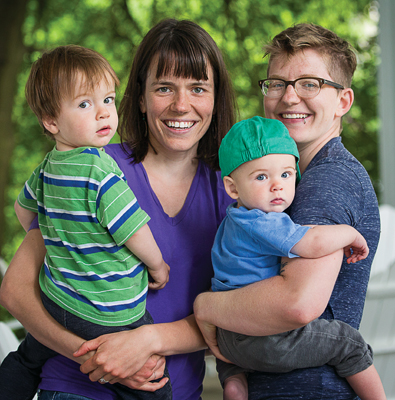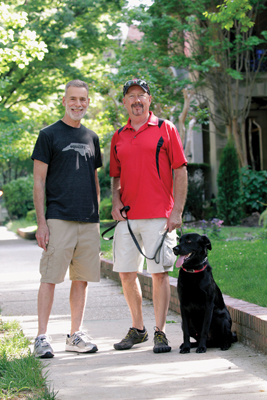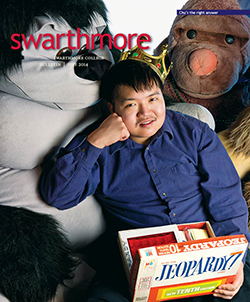Living Genuinely
Across the generations, LGBT alumni navigate post-DOMA marriage equality

The Belc family, from left, Sean, Anna, Samson, and Krys, enjoyed a late-spring visit to campus. “I went to Swarthmore and became a know-it-all; it’s really hard being a know-it-all when you have babies,” says stay-at-home mom Krys, who blogs about parenting experiences at babybelc.blogspot.com. Photo by Laurence Kesterson.
The marriage equality movement in America is turning a corner. Equal rights that allow same-sex partners to wed have presidential endorsement, support from a majority of Americans, and even have elicited a surprisingly laissez-faire attitude from Pope Francis. The movement is gaining so much momentum that statistics and facts are outdated almost before appearing in print. LGBT couples now find themselves at that gray intersection in history’s crossroads, where loopholes abound and the rules shift state by state.
According to an April poll by The Washington Post, 59 percent of Americans support same-sex marriages, which are legal in 19 states and federally recognized after last year’s dismantlement of Section 3 of the Defense of Marriage Act (DOMA). With the DOMA decision, various state bans on same-sex marriage fell—however, there are 31 of what Steve Melov ’71 calls “inequality states.”
In September, Steve, a retired federal employee and his partner of 39 years, Al Goddard, a retired elementary-school teacher, wed in the marriage-equality state of Maryland. There was just one “ironic caveat”: The couple had sold their house in Takoma Park, Md., in October 2012 to retire in North Carolina and, “as politics or the gods would have it, in May 2012, North Carolina voters amended the state constitution to define marriage as solely between one man and one woman,” says Steve.
Nevertheless, at 8 a.m., Sept. 13, the couple drove from their second home in Richmond, Va. (another inequality state), to Rockville, Md., to marry. Soon-to-be-spouses at the courthouse that day also included three heterosexual couples and a lesbian couple. On the ride home, Steve and Al found themselves wondering what all the fuss was about.
“We thought about all the time, money, and anxiety over who can marry—and then, within 15 minutes, we were married,” Steve says. “Nothing changed—in fact, we were married in Rockville, then we got into Virginia and we weren’t, at least not in the eyes of the state. It’s preposterous. Still, we never would have conceived of the possibility of marriage when we met in 1975.”

“Given that so many of our friends and acquaintances died of AIDS in the period between 1975 and now, Al and I both feel we were very fortunate to not just be together, but to be here and be alive,” says Steve Melov ’71 (left), with husband Al Goddard and Jagger, their lab rescue. Photo by Jay Paul
At Swarthmore, Steve says he was not aware of his sexuality. “It was inconceivable given the negative public image of homosexuals that I was brought up with.” Steve says that as a senior he learned of a few underclassmen who were gay, but it was sub rosa.
“I’ve thought about the term ‘coming out.’ It’s not about coming out, it’s about coming into. Coming into your life and what is authentic in your being,” explains Steve, who, along with his 4-foot-10 octogenarian mother, regularly testified for marriage equality in Maryland legislative hearings before her 2010 death.
“Swarthmore was an excellent incubator for coming into one’s life,” Steve says. “It taught me to trust in a balance of intellect, passion, and heart to move forward with what I believe in.”
* * *
Seated at a small wooden kitchen table in the Kensington section of Philadelphia, Anna Belc ’07 shrugs and pronounces casually, “Swarthmore’s the easiest place in the world to be queer.” Dating a woman on campus, she says was “not a big deal.”
Sitting next to spouse Krys McIlraith Belc ’09 while their two sons are tucked away for the night, Anna provides the color commentary, and Krys often fills in background and offers analysis. Krys explains that they met during Anna’s senior year, her sophomore year, on Swarthmore’s women’s rugby team. “I know that’s, like, super-gay,” she says, laughing. The Belcs have been married twice, first in a 2010 “big-white-dress” civil union in New Jersey and again at the New York City Hall in 2012 for full marital status.
These days, they’re consumed with raising sons Sean, 2, whom Anna delivered, and Samson, 11 months, whom Krys carried. Both boys were conceived with the help of a sperm donor, someone the couple knows and occasionally sees. Krys and Anna, who have formally adopted each other’s child, have plans for two more, but being pregnant again is not high on Krys’ agenda.
“I’m in a good place now, but having a baby really messed me up,” says Krys. “I felt like I was at the pinnacle of understanding myself [as genderqueer—a nonconforming gender designation that does not identify with traditional male or female precepts]. Then I decided to have a baby. I was a hormonal mess,” Krys says before Anna cuts in with, “She turned into a girl! She would say, ‘I’m upset and I don’t’ know why. Is this how you always feel?’ I was like ‘Yes!’ ”
Krys, who’s on a yearlong leave from her special-education job at a charter school, talks of moving the family out of Philadelphia, but says discussions often stall, due to the number of inequality states.
“Being queer is geographically limiting,” says Anna, who has found her fellow nurses at the Hospital of The University of Pennsylvania and the city to be accommodating even before Pennsylvania’s recently designated equity status. “[Krys and I] talk about moving somewhere else, like North Carolina, but while kids we adopt here would still be our kids in North Carolina, if I had a kid in North Carolina, Krys couldn’t adopt,” she says, looking at her spouse. At the same time, they sigh.
* * *
Seated in front of his computer in his Richmond, Va., apartment, husband Al puttering in the background, Steve reads the nearly 200-word missive he submitted in lieu of signing the ersatz individual federal forms that North Carolina required to be submitted along with his 2013 state taxes. While the couple can file federal taxes jointly, the matter becomes sticky in North Carolina, requiring Al and Steve to file five returns: one joint federal and two sets of individual federal and state taxes.
“I can’t think of anything more debasing than having a state tell you that you are not married when you are. It’s no way to treat a citizen of the United States,” Steve says, shaking his head. “We live our lives just like any other loving couple. I don’t think we’ve lived our lives courageously; I just think we’ve lived our lives genuinely.”
 Email This Page
Email This Page